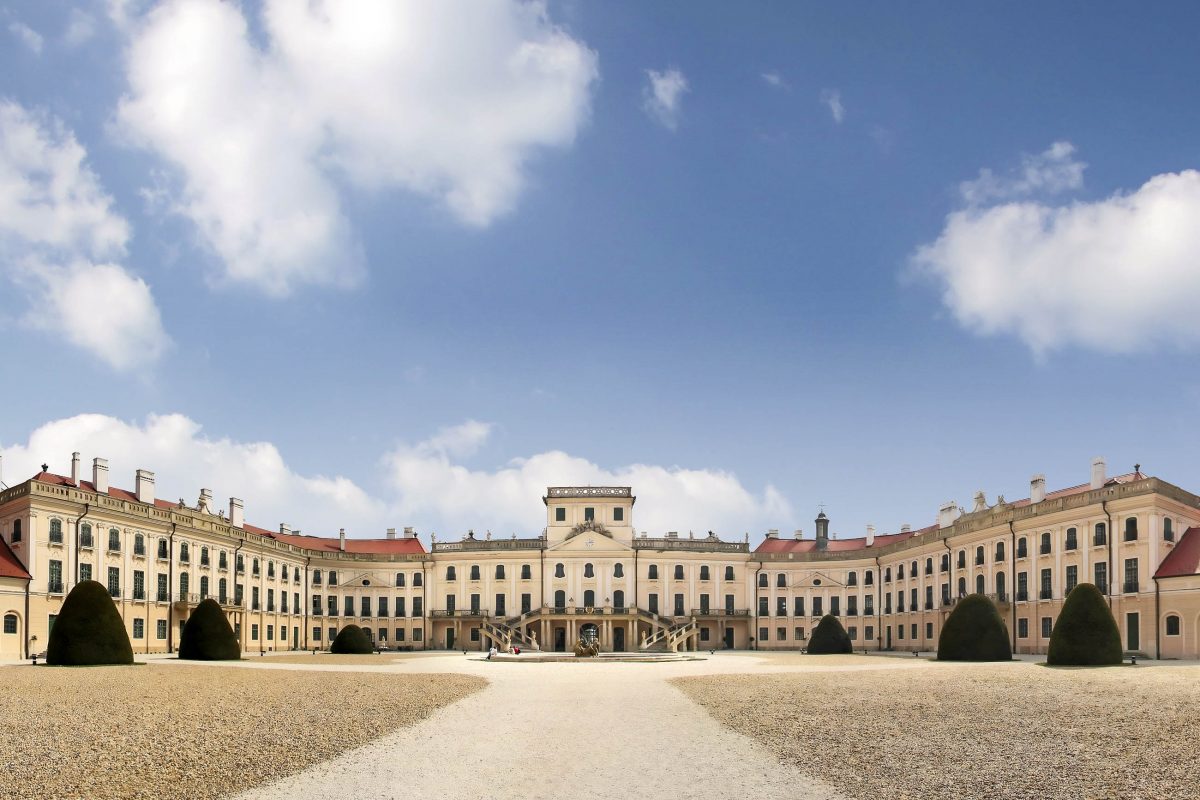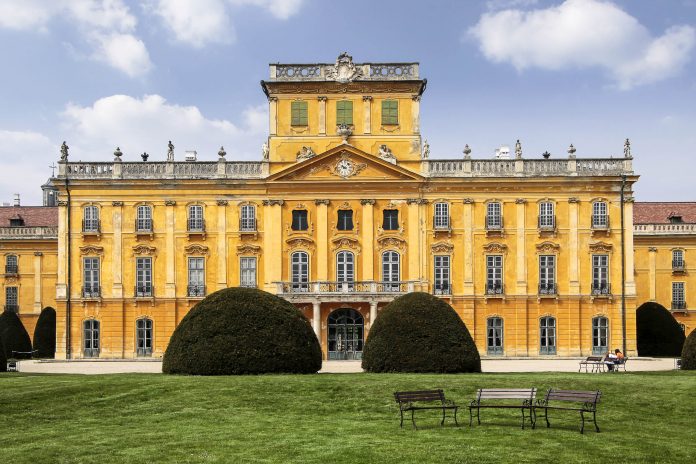Das Schloss Esterházy in der ungarischen Stadt Fertöd stammt aus dem 18. Jahrhundert und wird treffenderweise auch als „ungarisches Versailles“ bezeichnet. Der Komponist Joseph Haydn verbrachte dort viele Jahre als Hofkomponist und schuf in Fertöd eine Vielzahl seiner Werke.
Das ungarische Schloss Esterházy befindet sich am Stadtrand von Fertöd im Westen Ungarns nahe der Grenze zur Österreich etwa 25km von Sopron entfernt. Das prachtvolle Schloss der Familie Esterházy zählt zu den größten und schönsten Rokokoschlössern Ungarns. Die Fassade des eindrucksvollen Schlosses wird von einem prachtvollen Schlossgarten in Szene gesetzt.
Inhaltsverzeichnis
Wie kommt man am besten zum Schloss Fertöd?
Das bezaubernde Schloss kann mit dem Auto leicht über den österreichischen Seewinkel im Osten des Neusiedler Sees erreicht werden. Eine weitere Möglichkeit ist die Anreise mit dem Fahrrad, denn der idyllische Grenzland-Radweg, der den Neusiedlersee umrundet, führt direkt am Schlosspark vorbei.
Entstehung des „ungarischen Versailles“

Das Schloss Esterházy war ursprünglich ein kleines Jagdschloss von Michael Fürst Esterházy. Fürst Nikolaus I. beschloss jedoch im Jahr 1746 nach seiner Reise nach Paris, das Schloss nach dem Vorbild von Versailles umzubauen und beauftragte die Wiener Hofbaumeister Johann Ferdinand Mödlhammer und Melchior Hefele mit der Bauleitung.
Die Verwandlung des kleinen Schlösschens in den heutigen Prachtbau dauerte 46 Jahre lang. Die Steine für das Schloss wurden aus Österreich beschafft und stammen von den Steinbrüchen in St. Margarethen im Burgenland und Eggenburg in Niederösterreich. Deutliche Ähnlichkeiten des Schlosses Esterházy sind nicht nur zum Pariser Schloss Versailles, sondern auch zum Schloss Schönbrunn in Wien zu erkennen.
Nikolaus Esterházy starb im Jahr 1790 und weder sein direkter Nachfolger Anton, noch dessen Kinder wollten in dem abgeschiedenen Städtchen wohnen. Erst 100 Jahre später, als die Familie wieder Geld hatte, zog Nikolaus IV. mit seiner Familie in das zuvor renovierte Gebäude ein. Nach dem zweiten Weltkrieg wurde die Familie Esterházy in Ungarn enteignet und das Schloss verfiel abermals. Heute wird es vom Staat Ungarn erhalten und dient als Museum und Veranstaltungsort.
Prachtvolles Innenleben des Schlosses Esterházy
Durchschreitet man das Haupttor tut sich einem ein idyllisch angelegter Innenhof mit Kieswegen und prachtvollen Blumenbeeten auf. Der Mittelteil des Schlosses Esterhazy fungiert heute als Museum und kann im Rahmen von Führungen besichtigt werden, die eine gute Stunde dauern.
Das gewaltige Schloss umfasst 126 Räume, einer prächtiger ausgestattet als der andere. Hervorzuheben ist zum Beispiel der Bankett-Raum, dessen Decke ein Gemälde des griechischen Gottes Apollo in seinem Streitwagen ziert.
Auch die eindrucksvolle Bibliothek mit 22.000 Bänden und der italienisch angehauchte grottenähnliche Sala Terrana mit einem Deckengemälde aus Engeln, die sich um den Buchstaben „E“ für „Esterházy“ gruppieren, sind einen Besuch wert. Das Schloss beherbergte außerdem zwei Opernhäuser, ein Marionetten-Theater und einen Konzertsaal mit 400 Plätzen, der unglücklicherweise im Jahr 1779 einem Feuer zum Opfer fiel.
In einem Seitenflügel wurden zwei Schulen eingerichtet, eine für Gartenbaukunst und eine für kaufmännische Belange, die mit der österreichischen Handelsakademie in Frauenkirchen zusammenarbeitet und zweisprachig unterrichtet.
Berühmter Besuch: Joseph Haydn
Der österreichische Komponist Joseph Haydn, Esterhazy’scher Hofkomponist und Begründer der Wiener Klassik verbrachte hier, ebenso wie im Schloss Esterházy im burgenländischen Eisenstadt viele Jahre seine Lebens. Als Hofkomponist folgte er dem Fürsten und hielt sich somit im Winter meist in Eisenstadt, im Sommer meist in Fertöd in seiner eigenen Vierzimmer-Wohnung auf.
Das ungarische Schloss Esterházy war zum Beispiel im Jahr 1772 Schauplatz der Uraufführung der berühmten „Abschiedssymphonie“, bei der am Schluss nur noch ein einziger Musiker im Orchestergraben das festliche Stück zu Ende spielt.
Weiterführende Links:
Offizielle Seite des Schlosses Esterházy inkl. Öffnungszeiten, Führungen und Eintrittspreise





